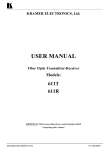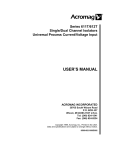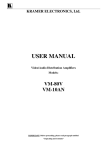Download USER MANUAL - AV-iQ
Transcript
KRAMER ELECTRONICS, Ltd. USER MANUAL Fiber Optic Transmitter-Receiver Models: 611T 611R IMPORTANT: Before proceeding, please read paragraph entitled "Unpacking and Contents" Table of Contents Section Name Page 1 1.1 1.2 2 3 4 4.1 5 5.1 6 6.1 6.2 7 7.1 7.1.1 7.1.2 7.2 8 9 10 11 11.1 INTRODUCTION A Word on Fiber Optics Factors Affecting Quality of Results SPECIFICATIONS HOW DO I GET STARTED? UNPACKING AND CONTENTS Optional Accessories FIBER OPTIC VIDEO TRANSMITTER AND RECEIVER Getting to Know Your 611T and 611R fiber optic transmitter and receiver INSTALLATION Rack Mounting Connecting to Video Devices USING the 611T and 611R Adjusting the Devices Adjusting HF (High Frequency) loss Adjusting video levels Using Component video with the system ADDING AUDIO TO THE SYSTEM TYPICAL APPLICATION TAKING CARE OF YOUR FIBER OPTIC DEVICES TROUBLESHOOTING Video and other High Frequency Signals Limited Warranty 2 2 3 3 3 4 4 5 5 6 6 7 7 7 7 7 8 8 8 8 9 9 10 List of Illustrations Figure 1 2 3 611T Front/Rear Panel Features 611R Front/Rear Panel Features Typical application using the 611T/611R system 5 6 8 List of Tables Table 1 2 611T Front/Rear Panel Features 611R Front/Rear Panel Features 5 6 1 INTRODUCTION Congratulations on your purchase of this Kramer Electronics fiber optic interface. Since 1981 Kramer has been dedicated to the development and manufacture of high quality video/audio equipment. The Kramer line has become an integral part of many of the best production and presentation facilities around the world. In recent years, Kramer has redesigned and upgraded most of the line, making the best even better. Kramer’s line of professional video/audio electronics is one of the most versatile and complete available, and is a true leader in terms of quality, workmanship, price/performance ratio and innovation. In addition to the Kramer line of high quality switchers, such as the one you have just purchased, Kramer also offers a full line of high quality distribution amplifiers, processors, interfaces, controllers and computer-related products. This manual includes configuration, operation and option information for the following products from the Kramer line of fiber optic interfaces. The machines described in this manual are listed below: 611T – Fiber optic video transmitter 611R – Fiber optic video receiver 1.1 A Word on Fiber Optics In many studio applications, signals are transmitted from one location to another. The standard way to transmit signals, whether video or audio is by using coaxial cables. This is an appropriate way when the distance between the transmitter and receiver does not exceed several tens of meters, depending on signal bandwidth and cable quality. Quality deterioration is inevitable, but in most studio applications, where standard, short-distance cabling is used, it is acceptable. In order to overcome signal losses in long distance applications, several solutions are available - namely, line amplifiers which allow at least doubling of the operation distance, or a twisted pair system. A twisted pair system uses different types of cables and special interface units, extending the effective range up to 1km or so. With a good quality system, broadcast level signals can be handled over hundreds of meters. The problem of quality signal transmission and reception becomes serious when signals have to travel distances of several kilometers. In this case, neither the line amplifier solution nor the twisted-pair solution is appropriate. A good option for high quality signal transmission over several kilometers distance is the fiber optic solution. This system uses a ray of light travelling in a tiny optic fiber carrying the signals. The transmitting device converts the electric signal (video or audio) into the form of a modulated light signal. The modulated light signal (usually red or infrared) is forwarded to a special connector that couples the modulated light signal to the optic fiber. The receiver is connected to the other side of the fiber, which is equipped with appropriate connectors (there are several different types of connectors used for fiber optic signal transmission systems). The receiver reconverts the ray of modulated light back to an electric signal, which is a copy of the original signal introduced to the transmitter. The 611T/611R uses the fiber optic Multi-Mode system, which has a range of up to 5 km. Thick optic fibers are used, which are easy to manufacture and to install. KRAMER ELECTRONICS LTD 2 1.2 Factors Affecting Quality of Results The factors affecting the quality of results when video or audio signals are transmitted from a source to an acceptor are: Connection cables Sockets and connectors of the sources and acceptors Distance between sources and acceptors Interference from neighboring electrical appliances 2 Low quality coaxial cables are susceptible to interference; they degrade signal quality due to poor matching and cause elevated noise levels. They should therefore be of the best quality. The fiber optics system is no exception to this rule. So often ignored, they should be of highest quality, since "Zero Ohm" connection resistance is the objective. Sockets and connectors also must match the required impedance (75ohm in video). Cheap, low quality connectors tend to rust, thus causing breaks in the signal path. The sockets’ quality is critical for proper optic fiber signal transmission as bad sockets cause energy loss and fast signal degradation. Plays a major role in the final result. For long distances (over 15 meters) between sources and acceptors, special measures should be taken in order to avoid coaxial cable losses. These include using higher quality cables or adding line amplifiers. These can have an adverse effect on signal quality. Balanced audio lines are less prone to interference, but unbalanced audio should be installed far from any mains power cables, electric motors, transmitters, and so on, even when the cables are shielded. The optic fiber system is practically immune to electric interference, as the signals transmitted along the optic fiber are rays of light and not electrical signals. SPECIFICATIONS T-611R Set 3 FUNCTION Fiber optic Video Transmitter / Receiver INPUTS Composite Video, 1Vpp/75 ohm on a BNC (611T), Optic Fiber ST connector (611R). OUTPUTS Optic Fiber ST connector (611T), Composite Video, 1Vpp/75 ohm on a BNC (611R). OPERATION RANGE: Up to 5km (Multimode). VIDEO BANDWIDTH 55 MHz (-3dB), 20 MHz (-0.1dB). VIDEO S/N RATIO DIFF. GAIN: Better than 60 dB. <0.4%. NON-LINEARITY <0.6%. CONTROLS DIMENSIONS Gain and cable Equalization on both the 611T and the 611R. 12cm X 7.5cm X 2.5cm (4.7"x 3 "x 2", W, D, H.) WEIGHT 0.27 kg. (0.59 Lbs.) Approx. POWER SOURCE 12 VDC, 80mA (611T), 40mA (611R). HOW DO I GET STARTED? The fastest way to get started is to take your time and do everything right the first time. Taking 15 minutes to read the manual may save you a few hours later. You don’ t even have to read the whole manual. At the beginning of each section, you’ ll find an overview of the section. If the section doesn’ t apply to you, you don’ t have to spend your time reading it. KRAMER ELECTRONICS LTD 3 4 UNPACKING AND CONTENTS The items contained in your package are listed below. Save the original box and packaging materials for possible future shipment. Fiber optic Transmitter/Receiver User Manual Power supply (12 Volts DC wall transformer) Mounting brackets For additional information regarding optional cables and additional accessories, contact your Kramer dealer. 4.1 Optional Accessories The following accessories, which are available from Kramer, can enhance implementation of your switcher. Rack Adapter – Allows the machines to be mounted in a standard 1U or 3U height rack. One or more machines may be installed on each adapter. BNC "Y" Connector - Used for looping purposes and splits the incoming signal to enable connection of an additional machine. SP-11 - (Video/Audio Processor) can be serially connected between the video/audio source and the fiber optic transmitter for video control/correction. The machine may provide camera control and luminance/white balance correction. The SP-11 is also capable of performing Composite to Y/C switching and bi-directional Transcoding. The machine allows full control over the video signal: Video gain down to full fade, log or linear Definition control, log or linear Contrast control, Color saturation control, Black Level control, Red, Green and Blue controls and a Screen Splitter control for “before-after” comparison. VM-1010 - (Video Distribution Amplifier) can be serially connected between the fiber optic receiver and the acceptors for video distribution. It is a full broadcast, state-of-the-art, and programmable video distribution amplifier. The VM-1010 has two looping video inputs, each splitting to 5 outputs. The user may select 2x1:5 or 1:10 operation via front panel control switches. Several VM-1010 units may be chained through the looping inputs. Output signals are DC or AC coupled (user selectable) for maximum flexibility. VM-20ARII - (Programmable Video/Audio Distribution Amplifier) can be serially connected between the fiber optic receiver and the video/audio acceptors for video/audio distribution. It is a full bandwidth, state-of-the-art, 1:20 Programmable video/audio distribution. The VM-20ARII splits a single video and audio input source into twenty identical outputs with no discernible signal degradation. The VM-20ARII has four looping video and audio (stereo) inputs and a user programmable mode of operation. The VM-20ARII can function as a 1:20, 2x1:10, 4x1:5 or 1:10+2x1:5 DA, and audio operation mode may be separated from video mode. Output signals are DC or AC coupled (user selectable) for highest signal fidelity. Due to the extended bandwidth of the machine it can also be used for video/graphics component distribution. The machine has video gain and EQ. controls for 4 sets of 5 outputs, as well as audio level controls. The audio may be programmed to function as an unbalanced stereo or a balanced mono distributor. VIDEO TESTER - A unique, patented, indispensable tool for the video professional, the Video Tester is used to test a video path leading to/from a video device. By pressing only one touch switch it can trace missing signals, distinguish between good and jittery (VCR sourced) signals, and identify the presence of good signals. Whenever a video signal is missing, because of bad connections, cable breaks or faulty sources, the Video Tester is all you need. No need for oscilloscopes, waveform monitors or a Vectorscope to trace and rectify such common problems. Indispensable for fieldwork, the Tester checks for sync and odd/even data in the signal and is not triggered by noise, hum or even by a 15kHz non-video source. The Video Tester is compact (not much bigger than a cigarette box), housed in sturdy plastic housing with pocket clip and is operated by a 9Volt battery for three continuous hours of operation (the full shelf life of the battery). VA-11 and VA-12 may be used to add two channels of audio to the video signal, to be transmitted using one fiber optic transmitter (611T) and receiver (611R) set. The VA-11 Video-Audio Combiner sends a color video signal and a stereo audio signal using only one standard coax cable. The VA-11 maintains the bandwidth of an industrial color video signal, and the output signal may be viewed and recorded as a normal video signal. By using the KRAMER VA-11 together with the VA-12 (Video-Audio Separator), the audio-stereo signal may be recovered; so audio signals may be sent in a hidden mode, to be recovered only by a VA-12. KRAMER ELECTRONICS LTD 4 5 FIBER OPTIC VIDEO TRANSMITTER AND RECEIVER This section describes all the controls and connections of your fiber optic device. 5.1 Getting to Know Your 611T and 611R fiber optic transmitter and receiver The Kramer 611T is a high performance composite video to fiber optic transmitter, and the 611R is its receiving unit which converts the fiber optic signal back to standard video. Transmission via fiber carries signals much farther than ordinary coax cable, and is lighter. Another advantage of fiber transmission is complete ground isolation between source and display. A simple system consists of a 611T located at the video source, and a 611R at the display device. Standard units use “multimode” technology allowing transmission up to 5 kilometers. A 12V power supply is provided with each unit. Both units are part of the Kramer TOOLS family of compact, high quality, and cost effective solutions for a variety of applications. Front/rear panel features of the 611T are described in Figure 1 and Table 1. Figure 1: 611T Front/Rear Panel Features Table 1: 611T Front/Rear Panel Features No. 1 2 3 4 Feature TO FIBER INPUT GAIN HF Function “ST” type connector outputting the converted video signal to the optical fiber Video input connector on a BNC Video level control trimmer Cable compensation (High Frequency) control trimmer 5 ON Power ON indication LED 6 12V DC 12 Volts DC feed to the machine KRAMER ELECTRONICS LTD 5 Front/rear panel features of the 611R are described in Figure 2 and Table 2. Figure 2: 611R Front/Rear Panel Features Table 2: 611R Front/Rear Panel Features No. 1 2 3 4 6 Function Feature GAIN HF OUTPUT FROM FIBER 5 ON Video level control trimmer Cable compensation (High Frequency) control trimmer Video output connector on a BNC “ST” type connector inputting the converted video signal from the optical fiber to the 611R Power ON indication LED 6 12V DC 12 Volts DC feed to the machine INSTALLATION 6.1 Rack Mounting The 611T and 611R come with mounting brackets for tabletop mounting. The machines may be rack-mounted in a standard 19” (1U) EIA rack assembly using an optional rack adapter. KRAMER ELECTRONICS LTD 6 6.2 Connecting to Video Devices 7 1. Connect a video source to the video input BNC of the 611T machine using recommended cables, taking care that all connections are correct. 2. Connect the appropriate optic fiber (that is, Multimode fiber) to the “ST” type TO FIBER connector of the 611T. Be sure that only Multimode fiber is used. The use of a wrong component in the system will cause a total malfunction of the fiber optic system. 3. Connect the remote side of the optic fiber to the FROM FIBER “ST” connector of the 611R receiver. Be sure that the connection is firm and positive. 4. Connect a coaxial cable between the OUTPUT BNC of the 611R to the input of the video acceptor. 5. Connect the 611T and 611R to an appropriate 12V DC source, observing proper polarity (the provided Kramer wall transformer is recommended). The ON LEDs on both the 611T and 611R should light up. 6. Operate your video source and acceptor. USING the 611T AND 611R 7.1 Adjusting the Devices Both the 611T and the 611R come with video level trimming devices. In normal use, the trimmers should not be touched, as the machines are pre-adjusted at the factory for transparent operation. If the optic fiber and connectors are of good quality and the operating range is not exceeded, the trimmers should be left in the factory preset state. If a signal definition loss is encountered (the video image gets unsharp or “smeared” or the color information looses clarity and color noise appears) the first thing to do is to check the cables and connectors (both the video and the optic fiber) and the quality of the video source and the video receiver. The quality of the video source may be checked by direct connection of the source to a monitor, bypassing the optic fiber system. If everything looks fine but the video image is still bad, then the following steps should be taken (bear in mind though, that the factory preset for 1:1 transparency will be lost): 7.1.1 Adjusting HF (High Frequency) loss First, with an isolated plastic screwdriver, carefully adjust the HF trimmer of the 611T machine and monitor the results at the remote location (with a second person at the remote location.) If there is an improvement in the video signal clarity, and noise is not accumulated, but the improvement is not sufficient - even at the maximal setting of the trimmer, repeat the process at the 611R side (remote location.) 7.1.2 Adjusting video levels If the video signal is too dark and faint at the remote location, the video level should be adjusted. Again, in normal use, the trimmers should not be touched, as the machines are pre-adjusted for transparent operation at the factory. If the optic fiber and connectors are of good quality and the operating range is not exceeded, the trimmers should be left at the factory preset state. The video trimmer adjusting levels, if incorrectly set, may cause severe image degradation. If the video signal entering the 611T is at normal video levels (1Vpp) then readjusting the level will deteriorate the system’ s linearity. The video signal level entering the 611T should be monitored with an oscilloscope or another video measurement device. The adjustments– after verifying that there is indeed a deterioration of the video signal level- is first done at the receiving end, the 611R. Using an insulated screwdriver, adjust the LEVEL trimmer at the 611R side. If there is an improvement in the video signal level (the image gets brighter) and noise is not accumulated, but the improvement is not sufficient - even at the maximal setting of the trimmer, repeat the process at the 611T side (local transmitting location.) It is not very likely that the signal level will deteriorate, unless there is something wrong with the system – either the distance of operation is too large, the video signal is double loaded or a wrong combination of transmitter/receiver/fiber is used! KRAMER ELECTRONICS LTD 7 7.2 Using Component video with the system The 611T and 611R system is designed to transfer a Composite video signal. The wide bandwidth of the system allows transfer of Component video signals by using multiple sets of machines. Two sets can be used to transfer s–Video signals (Y and C) and three sets can be used to transfer Component video (Y, U, V). In each case the cable lengths of all the signals involved (video cables and the optic fibers) should be of equal lengths. Adjustment, if needed, may be done as explained above. 8 ADDING AUDIO TO THE SYSTEM Although the 611T and 611R pair is designed to carry video signals, audio may be added to the system. The Kramer VA-11 and VA-12 allows combining and separating two stereo audio signals and a video signal to and from one coaxial connector. The VA-11 combines two audio channels (stereo) and a video signal to a “MIXED” output. This mixed signal may be fed into a 611T transmitter, transferred over a long distance and recovered via the 611R receiver. The recovered “MIXED” signal may be fed into a VA-12, which will separate the signal into its audio and video components. Other signals, such as low frequency data signals and so on, may be used instead of one or both audio channels. The 611T/611R set may be used for digital audio (AES/EBU) transmission instead of Composite video. 9 TYPICAL APPLICATION A typical application, which is self-explanatory, is described below in Figure 3: Figure 3: A typical application using the 611T/611R system 10 TAKING CARE of YOUR FIBER OPTIC DEVICES Do not locate your device in an environment where it is susceptible to dust or moisture. Both of these may damage the electronics, and cause erratic operation or failure. Do not locate your device where temperature and humidity may be excessive. The fiber optic transmitting and receiving chips are very sensitive to heat. Doing so may also damage the electronics, and cause erratic operation or failure of your machine. Do not clean your machine with abrasives or strong cleaners. Doing so may remove or damage the finish, or may allow moisture to build up. Take care not to allow dust or particles to build up inside unused or open connectors. KRAMER ELECTRONICS LTD 8 11 TROUBLESHOOTING 1. Please note that if the output signal is disturbed or interrupted by very strong external electromagnetic interference, it should return and stabilize when such interference ends. If not, turn the acceptor/source power switch off and on again to reset the machine. 2. If the following recommended actions still do not result in satisfactory operation, please consult your KRAMER Dealer. 11.1 Video and other High Frequency Signals Problem No signal at the output device, regardless of input selected. Signal level is too high or too dim. Problem Noise bars "roll" up or down in the output image or: Low Frequency Hum in the output signal Remedy 1. Confirm that your sources and output device are powered on and connected properly. 2. Confirm that any other devices in the signal path have the proper input and/or output selected. 3. Confirm that the distance used in your system is not larger than the recommended distance for this optic fiber system. 4. Use a Video Tester to test the video path leading to/from your transmitter /receiver (see section 4.1 " Video Tester") 1. Verify that the video signal is well matched through 75ohm impedance; otherwise it results in a signal level that is too high or too dim. 2. Confirm that you are using the right optic fiber cable suitable for the system, and that you are within the recommended operating range. 3. Confirm that there are no sharp bends or breaks along the optic fiber. Sharp bends or loops deteriorate the signal due to energy loss resulting from reflections and exceeding of the critical angle of transmission. Adjust levels if needed, as described in sections 7.1.1 and 7.1.2. 4. Confirm that the video connecting cables are of high quality, properly built and terminated with 75ohm BNC connectors. Check level controls located on your source input device or output display or recorder. Remedy The fiber optic system is free from induced hum and ground currents, as it provides a pure galvanic isolation, however, this problem may appear in your system due to other components used. Hum bars (ground loop) are caused by a difference in the ground potential of any two or more devices connected to your signal path. This difference is compensated by passing that voltage difference through any available interconnection, including your video cables. WARNING! DO NOT DISCONNECT THE GROUND FROM ANY PIECE OF VIDEO EQUIPMENT IN YOUR SIGNAL PATH! Check the following to remove hum bars: 1. Confirm that all interconnected video equipment is connected to the same phase of power, if possible. 2. Remove equipment connected to that phase that may introduce noise, such as motors, generators, etc. 3. Disconnect all interconnect cables and reconnect them one at a time until ground loop reappears. 4. Disconnect the affected cable and replace, or insert an isolation transformer in the signal path. KRAMER ELECTRONICS LTD 9 Kramer Electronics (hereafter Kramer) warrants this product to be free from defects in material and workmanship under the following terms. HOW LONG IS THE WARRANTY Labor and parts are warranted for three years from the date of the first customer purchase. WHO IS PROTECTED Only the first purchase customer may enforce this warranty. WHAT IS COVERED AND WHAT IS NOT COVERED Except as below, this warranty covers all defects in material or workmanship in this product. The following are not covered by the warranty: 1) Any product which is not distributed by Kramer or which is not purchased from an authorized Kramer dealer. If you are uncertain as to whether a dealer is authorized, please contact Kramer at one of the agents listed in the web site www.kramerelectronics.com. 2) Any product, on which the serial number has been defaced, modified or removed. 3) Damage, deterioration or malfunction resulting from: a) Accident, misuse, abuse, neglect, fire, water, lightning or other acts of nature, unauthorized product modification, or failure to follow instructions supplied with the product. b) Repair or attempted repair by anyone not authorized by Kramer. c) Any shipment of the product (claims must be presented to the carrier). d) Removal or installation of the product. e) Any other cause, which does not relate to a product defect. f) Cartons, equipment enclosures, cables or accessories used in conjunction with the product. WHAT WE WILL PAY FOR AND WHAT WE WILL NOT PAY FOR We will pay labor and material expenses for covered items. We will not pay for the following: 1) Removal or installations charges. 2) Costs of initial technical adjustments (set-up), including adjustment of user controls or programming. These costs are the responsibility of the Kramer dealer from whom the product was purchased. 3) Shipping charges. HOW YOU CAN GET WARRANTY SERVICE To obtain service on you product, you must take or ship it prepaid to any authorized Kramer service center. Whenever warranty service is required, the original dated invoice (or a copy) must be presented as proof of warranty coverage, and should be included in any shipment of the product. Please also include in any mailing a contact name, company, address, and a description of the problem(s). For the name of the nearest Kramer authorized service center, consult your authorized dealer. LIMITATION OF IMPLIED WARRANTIES All implied warranties, including warranties of merchantability and fitness for a particular purpose, are limited in duration to the length of this warranty. KRAMER ELECTRONICS LTD 10 EXCLUSION OF DAMAGES Kramer’ s liability for any defective products is limited to the repair or replacement of the product at our option. Kramer shall not be liable for: Damage to other property caused by defects in this product, damages based upon inconvenience, loss of use of the product, loss of time, commercial loss; or: Any other damages, whether incidental, consequential or otherwise. Some countries may not allow limitations on how long an implied warranty lasts and/or do not allow the exclusion or limitation of incidental or consequential damages, so the above limitations and exclusions may not apply to you. This warranty gives you specific legal rights, and you may also have other rights, which vary from place to place. NOTE: All products returned to Kramer for service must have prior approval. This may be obtained from your dealer. NOTICE This equipment has been tested to determine compliance with the requirements of: EN-50081: EN-50082: CFR-47 "Electromagnetic compatibility (EMC); generic emission standard. Part 1: Residential, commercial and light industry" "Electromagnetic compatibility (EMC) generic immunity standard. Part 1: Residential, commercial and light industry environment". FCC Rules and Regulations: Part 15- “Radio frequency devices: Subpart B- Unintentional radiators CAUTION Servicing of the above mentioned machines is only allowed by a Kramer authorized technician or Engineer. Any user who makes changes or modifications to the unit without the express approval of the manufacturer will void user authority to operate the equipment. Use the DC power supply (provided) to supply power to the machine and controllers. Please use recommended interconnect cables to connect the machine to controllers and other components. KRAMER ELECTRONICS LTD 11 For the latest information on our products and a list of Kramer distributors, visit our Web site: www.kramerelectronics.com, where updates to this user manual may be found. We welcome your questions, comments and feedback. Safety Warning: Disconnect the unit from the power supply before opening/servicing. Caution Kramer Electronics, Ltd. Web site: www.kramerelectronics.com E-mail: [email protected] P/N: 2900-009009 REV 2





















